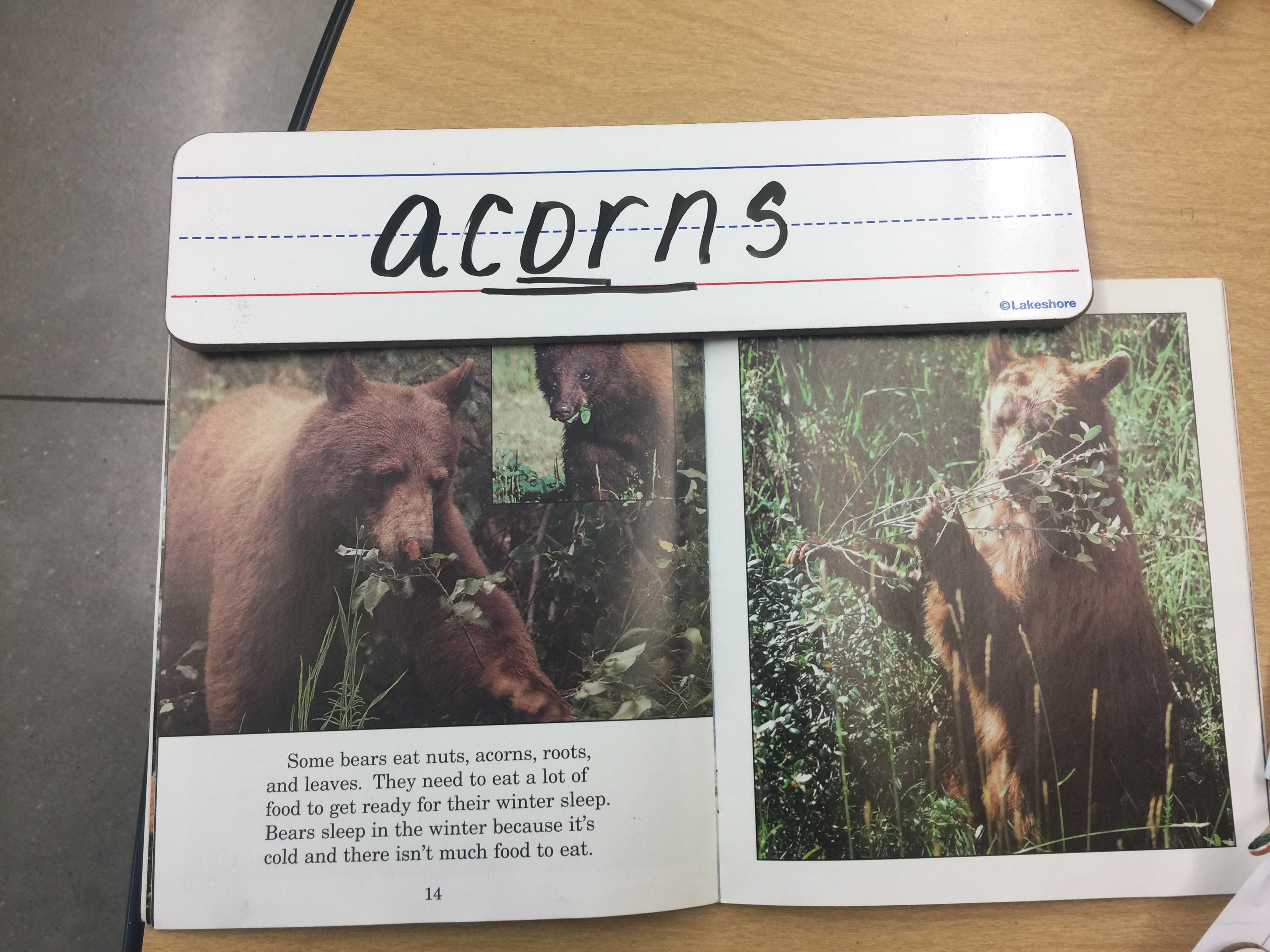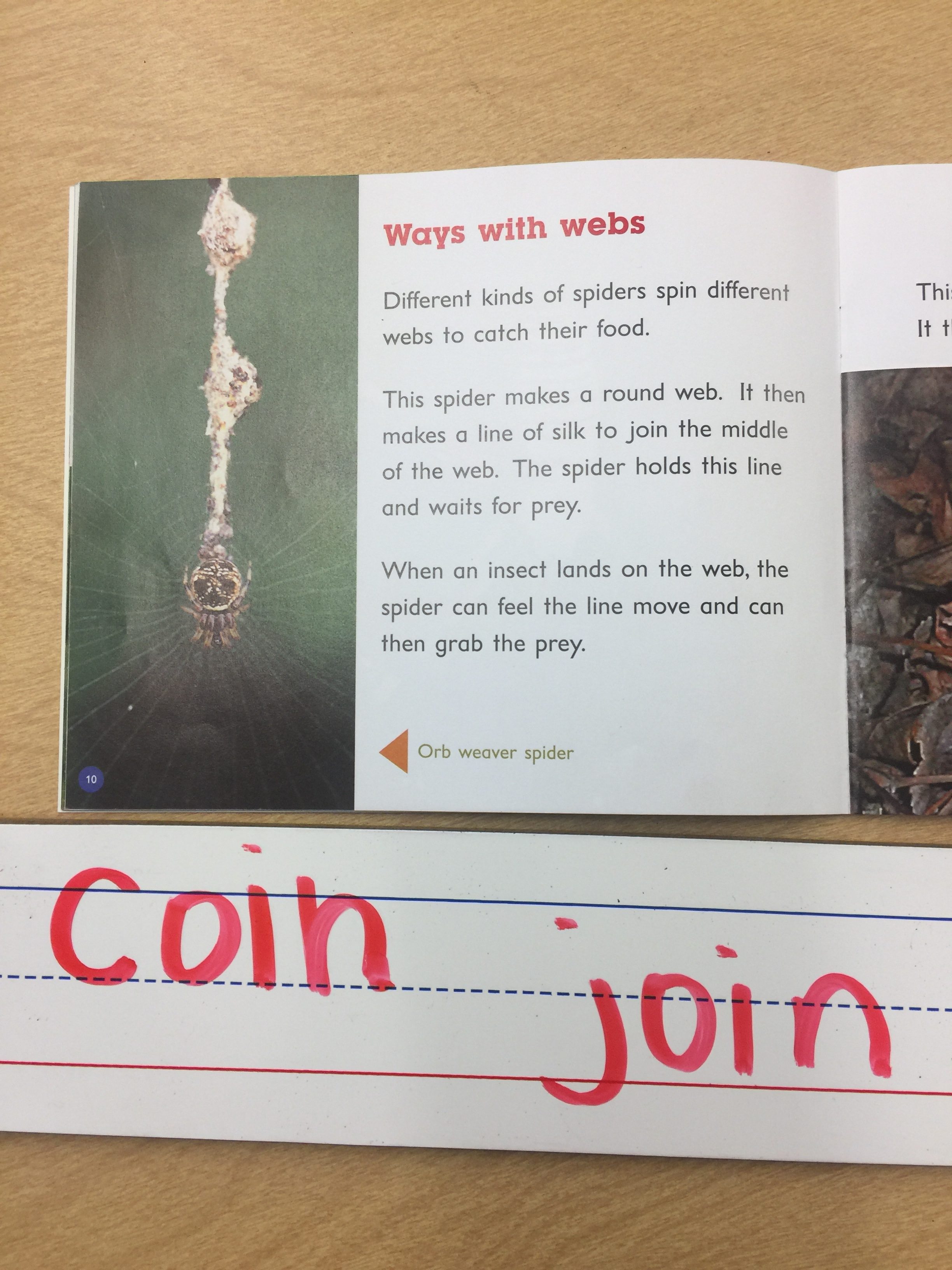When students at the transitional or fluent stage of reading (DRA levels 18+ or alpha levels J+) struggle with a word, there are a few “go to” strategies and prompts I rely on. (I’ve attached a file at the end that lists these prompts 🙂
- “Is there a part you know?” If it’s a word that has any parts they might know, I use this prompt. For example, a student was stuck on the word “acorns” in the sentence “Some bears eat nuts, acorns, roots and leaves.” I lifted the word “acorn” out of the text by writing it on a dry erase board and then prompted the student to “look for a part you know.” He was thrilled when he noticed the “or” and then his eyes grew wide when he noticed “corn” in the word as well. Decoding is not enough. Then I asked the student to reread and think with me about the meaning of that word. I said, “Let’s go back and reread that sentence. (Student reads aloud.) Now what does the word ‘acorn’ mean in this sentence?” and we discussed how it must be a food like the other items listed in the sentence. I closed by saying, “When you’re reading, you need to make sure that

- “Can you use a word you know to help you with this word?” Sometimes when a student is stuck, I look at the word and think about what part of the word they are struggling with. For example, one student was stuck on the word “join.” I knew the “oi” was causing her problems. I wrote the word “coin” on a dry erase board and asked, “Do you know this word?” She did and read it aloud to me. “Can you use the word ‘join’ to help you with the tricky word?” and she figured out “coin.” (BTW I’ve had this backfire when the student did not know the word I chose and then I just give it to them 😉 Then we reread and thought about the meaning of that word. She read the word in the text and we talked about what it meant.

- With some words, I’ll ask the student, “Can you use your finger to help you look at the parts?” or “Can you look at the parts with your eyes?” As they do, I encourage them to think about what they know about each part. As described in a previous blog, when a student got stuck on the word “burrow” — I helped him use his finger to cover the end and asked, “Do you know that first part?” He recognized it as “bur.” Then I coached him on how to cover the first part of the word and look at “row” which he did not know. Then I wrote “snow” on a dry erase board and he used that word to help him read “burrow.” Finally I asked him to reread the sentence and think with me about what the meaning of that word is. I do not use my finger to cover up parts of the words. The student must use his finger because later when he is alone trying to problem solve, he will not have my finger to help him 😉
- “Was there a tricky part?” If a student mumble reads a word, hoping I won’t notice that he doesn’t know the word, I let him finish the sentence and then I say, “Was there a tricky part?” Usually they nod and then I say, “Can you show me?” and have the student point the word out. Next I say, “What can you do?” Tips –
- Let the student finish the sentence first. If you stop them at the point of error, then you have done the monitoring.
- Keep your finger out of their book. Make them use their own finger. That’s part of the work you want them to do when they are alone, right?
- Sometimes I ask “Was there a tricky part?” and the student says, “Nope!” ;0 Then I ask them to reread the sentence and make sure what they are saying matches what they are seeing. If they notice their error, we talk about how what they said may have sounded right or made sense (if that’s appropriate), but it doesn’t look right.
- If the student does not know what the tricky part was – even after rereading, then I say, “Listen to me read this sentence. As I read, I want you to notice where what I say does not match what you see.”
- “Are you right?” and “How do you know?” or “What can you do?” If you have students who read a word or get stuck and automatically look up at you without problem solving, you need to nip this habit. If I know a student has been taught word solving strategies and they appeal to me, I shrug my shoulders and say, “Are you right?” No nodding. No “Good job.” Make them accountable. Follow up with “How do you know (you’re right or you’re wrong)?” and support them in verbalizing how they were strategic or what they need to do to be strategic.
- “That’s a word you just have to know.” When a student gets stuck on a word that has a mostly irregular spelling (e.g., only, unique, beautiful), I don’t dig a deep hole for myself trying to help them figure it out. I just say, “That’s a word you just have to know. It’s _____. Let’s reread that sentence and think about what it means.” In other cases, I might give them part of the word (the irregular or tricky part) and let them figure out the other parts. For example, a student got stuck on the word “certain.” He chunked it and after he’d gotten “cer” (with a soft c – ugh!!!), I gave him “tain.” Then we reread the sentence to think about how the word was used and why. AND in yet other cases, I just think, “That’s way over their head developmentally, I’m giving it to them and going on with my life!!!” That happens.
Honestly, if the word is not in the student’s vocabulary, they may not be able to figure out the correct pronunciation. What’s most important is that they at least understand the meaning of the word. That’s why I strongly encourage students to check for meaning. When I help a student with visual cues, I always reread the text with the word and discuss the meaning of that word with students (even words like “only”). You may have to help them use context clues to figure out the meaning of the word and sometimes there are no clues so you just give them the meaning. If you need a reminder about the types of context clues students can look for when they don’t know a vocabulary word in an informational source , see this blog entry I wrote.
Prompts for Supporting Word Solving
Sources that have helped me get better at prompting for word solving (in addition to a lot of practice) –
Next Step Forward (Richardson, 2017, p. 178)
Guided Reading: Responsive Teaching Across the Grades (Fountas & Pinnell, 2017, p. 414)
Teaching Strategic Processes in Reading (Almasi & Fullerton, 2012, Chapter 7–dense but hearty)
Hope this helps.
S
